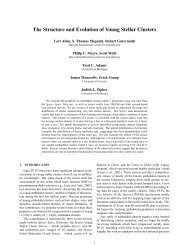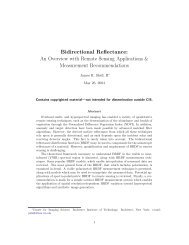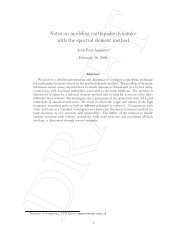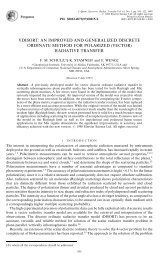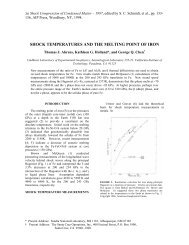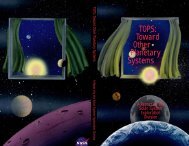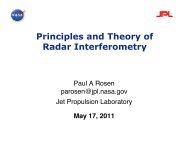VLIDORT User's Guide
VLIDORT User's Guide
VLIDORT User's Guide
You also want an ePaper? Increase the reach of your titles
YUMPU automatically turns print PDFs into web optimized ePapers that Google loves.
One of the features of the above outgoing sphericity correction is that the average-secantformulation is still assumed to hold for solar beam attenuation. In Eq. (2.102), the layer single−scattering source terms still contain the post-processing multipliers En( x,μ)which were derivedusing the average-secant exponential parameterization in terms of the vertical optical thicknesscoordinate for that layer (Eq. (2.92)).Figure 2 (lower panel) shows the geometry for the single-scattering outgoing sphericitycorrection along the line of sight. In a non-refractive atmosphere, the solar zenith angle, the lineof-sightzenith angles and the relative azimuth angle between the incident and scattering planeswill vary along path AB, but the scattering angle Θ is constant for straight-line geometry.For single scatter along AB, the current implementation in the LIDORT and <strong>VLIDORT</strong> codes isbased on the average secant approximation of the solar attenuation A (x)to a point along thepath with vertical optical thickness x measured from layer-top:1 ⎡ An−⎤A( x)= A n − 1exp[ −xλn]; λn= ln 1⎢ ⎥ . (2.104)Δn ⎣ An⎦Here An−1and An are transmittances to layer top and layer bottom respectively, and Δn is thewhole-layer vertical optical thickness. As noted above, the RTE in layer n is:dI(x)ωnFP(Θ)μn= I(x)+ An( x). (2.105)dx4πHere, μn is the averaged line-of-sight cosine defined as the vertical height difference of layer ndivided by the line-of-sight slant distance; ωn is the layer single scattering albedo with phasefunction Pn(Θ)(both are constants within the layer), and F is the solar flux. In the averagesecantapproximation, Eq. (2.105) has a straightforward solution that utilizes the exponentialdependence of the attenuation to deliver the following closed-form result:[ − snΔn] Jn1−exp[ −( sn+ λn)μ ( s + λ )I ↑ n= I↑−1 nexp + ; (2.106)Jn= HnAn−1nnnΔn]. (2.107)Here, 4 H FP ( Θ−1πn= ωn) and s n= μ n . The TOA result for the upwelling single scatteringradiation field is then found by recursion of Eq. (2.106).IN↑ ↑0= IsurfaceCN+ ∑ JnCn−1; (2.108)n=1n= ∏ exp[ − Δp] ; C0= 1. (2.109)p=1C ns pFor densely layered atmospheres, the average secant approximation is accurate enough for therange of solar angles considered so far. However, it has been shown [Spurr, 2002] that thistreatment loses accuracy for very high SZA and for layers that are optically or geometricallythick. A better treatment of outgoing single scatter is therefore required for the LIDORT codes –one that will produce reliable answers for all applications (not just the Rayleigh scattering UVozonescenarios), and in particular in the presence of cloud layers and for situations involving34



